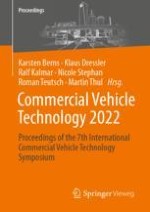2022 | OriginalPaper | Buchkapitel
H2 Direct Injection System for Heavy Duty ICE in transient On- & Off-Road Operation
verfasst von : Richard Pirkl, Mario D’Onofrio, Lydia Kapusta, Dennis Herrmann
Erschienen in: Commercial Vehicle Technology 2022
Verlag: Springer Fachmedien Wiesbaden
Aktivieren Sie unsere intelligente Suche, um passende Fachinhalte oder Patente zu finden.
Wählen Sie Textabschnitte aus um mit Künstlicher Intelligenz passenden Patente zu finden. powered by
Markieren Sie Textabschnitte, um KI-gestützt weitere passende Inhalte zu finden. powered by
One of the major targets today and in the near future is the reduction of greenhouse gas emissions (mainly CO2). CO2 reduction targets are defined for all onroad applications from the passenger car to the heavy-duty trucks. Yet there are no targets for off-road applications defined. This does not means that market players should not start to cope with this challenge right now.Liebherr develops fuel injection system solutions to be used in on- and off-road hydrogen combustions engines. This paper will show the simulation and test results based on real world Liebherr application profiles.Heavy-duty off-road applications have partly different requirements compared to onroad applications. Robustness against dust, dirt & vibrations and other harsh environmental conditions is mandatory. Additionally higher peak power demand and more dynamic load cycles increase the requirements on the transient performance of the engine.Fulfilling the requirements for the off-road applications will also be beneficial for onroad applications since one of the biggest challenges for hydrogen combustion engines in all applications is to achieve a power rating and drivability that is close to today's Diesel engines. Fulfilling the requirements on engine dynamics will most likely require a complete integrated H2 fuel injection system in order to achieve the requirements on dynamic fuel metering. This is why Liebherr put its focus on the design of a complete system rather than developing single components, with the advantage to offer an all-around solution. This paper will provide an overview on the Liebherr activities sparked to create a high performance H2 direct injection system.First the role of the combustion engine on the way to zero CO2 emissions and different concepts for hydrogen combustion engines will be discussed. Based on a real-world highly dynamic load cycle the requirements on the system are deducted. In the next step the major role of a system design that fits to the engine load profile will be explained. The target of the Liebherr H2 system is to ensure that the GIS (gas injection system) can fulfil transient requirements and pressure gradients. This system focused approach finally led to a layout combining different components to control pressure and flow such that same drivability as current Diesel machine as well as robust system design is achieved. Finally, the injector concept as key component and first test results will be presented.
